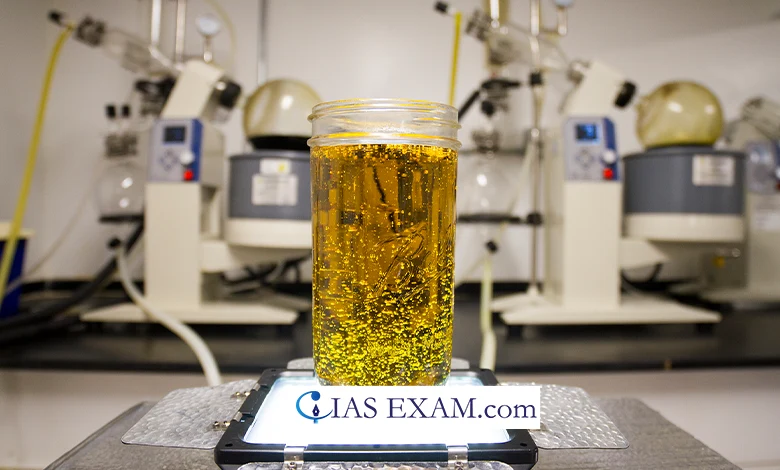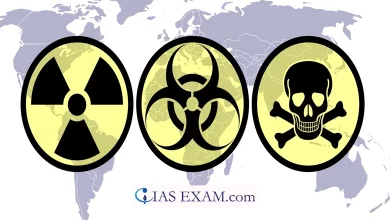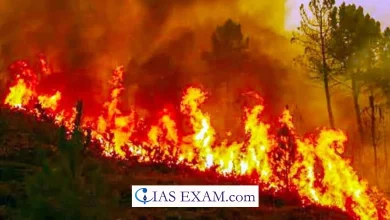
Context
Hydrocarbons, such as natural gas, coal, crude oil, and petroleum, are extracted from under the ground through a series of geological and engineering processes.
Hydrocarbons
- Hydrocarbons are organic substances composed solely of carbon and hydrogen atoms.
- They come in various forms and are extracted from the earth using different methods. Here’s a detailed look at the types of hydrocarbons and how they’re extracted:
Types of Hydrocarbons
- Alkanes (Saturated): These are the most experimented compounds and they are just linking one carbon with another with just a single bond and they are usually non-reactive, mainly used as fuels. Hence, methane (CH₄) and ethane (C₂H₆) are among the commonly listed ones.
- Alkenes (Unsaturated): Due to having double bonds between carbons, alkenes are more susceptible to reactions than alkanes. But their overall arrangement is typical CₙH₂ₙ.
- Alkynes: These aromatics are triple bonded between carbon atoms at the intersection and their general formula is CₙH₂ₙ₋₂.
- Aromatic Hydrocarbons: Arenes or contain aromatic rings may represent them and they are a basic precursor to the creation of many synthetic materials.
Geological Formation of Hydrocarbons
- Over and over time life forms decompose into oil as a result of the heating and the compaction processes in the earth crust, starting from several millions of years.
- This immiscible liquid trap is frequently in subterranean rocks which can be in reservoirs formed by a more resistant rock overlaying a less resistant one leading to the storing of hydrocarbons which are below the surface.
Exploration and Assessment
- Besides the different utilities of tools and methods, petroleum geologists study the occurrence of oil and gas in reservoirs.
- The engineers perform this feat by evaluating rocks’ porosity and permeability, which show the amount of hydrocarbon the rocks can hold as well as their ability to flow through the rocks
- This kind of hydrocarbon is formed by kerogen, a type of organic matter; there are some sources of it such as lake sediments, marine ecosystems, and continental.
Drilling and Extraction
- After identifying a location with potential for profitable hydrocarbon extraction, drilling operations commence. Drilling and reservoir engineers are responsible for extracting the hydrocarbons efficiently without damaging the reservoir.
- They use drilling rigs to reach the hydrocarbon deposits and then pump them out to the surface.
Environmental Considerations
- Air Pollution: Release of VOCs: Hydrocarbon extraction can lead to the release of volatile organic compounds (VOCs) into the atmosphere. These substances add to the problem of air pollution and can cause negative impacts on health.
- Water Contamination: Large oil spills are a significant source of environmental damage, contaminating water bodies and affecting marine life.
- Improperly abandoned wells can leak hydrocarbons into groundwater, leading to contamination of drinking water sources.
- Climate Change: Burning of hydrocarbons (hydrocarbons like carbon dioxide and methane) from the extraction leads to the increased levels of these gases in the atmosphere, so known as global warming.
- Land Degradation: From disturbing natural habitats continuously to deforestation, the infrastructure built for hydrocarbon extraction can be very disastrous.
- Soil Contamination: Invasions and spills in the course of seizing occur frequently which bring about soil poisoning and this is harmful to farmlands and biodiversity.
- Health Risks: The Ultrafine particles present in hydrocarbons can cause an increase in the incidence of respiratory problems in humans.
- Cancer: Certain hydrocarbons have been linked to an increased risk of cancer.
- Mitigation Measures: Implementing proper ventilation and emission control systems can help minimise the release of harmful substances into the environment. Solvent Recovery: Using solvent recovery methods can reduce the environmental footprint of hydrocarbon extraction.
- Transition to Cleaner Energy: The future lies in using cleaner energy sources, ie solar and wind energy, to lower greenhouse gas emissions and minimise their environmental effect.
Conclusion
The extraction of hydrocarbons is a complex process that requires careful planning and consideration of environmental impacts. As the world moves towards sustainable energy, the focus is also shifting to alternative sources that are more environmentally friendly.
Source: The Hindu
UPSC Prelims Practice Question
Q.Which of the following is the primary method used for extracting hydrocarbons from underground reservoirs?
a) Hydraulic fracturing
b) Drilling wells
c) Steam injection
d) Surface mining
Ans – b





.png)



